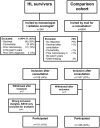High prevalence of advanced colorectal neoplasia and serrated polyposis syndrome in Hodgkin lymphoma survivors
- PMID: 30561773
- PMCID: PMC6590398
- DOI: 10.1002/cncr.31903
High prevalence of advanced colorectal neoplasia and serrated polyposis syndrome in Hodgkin lymphoma survivors
Abstract
Background: Hodgkin lymphoma (HL) survivors treated with abdominal radiotherapy and/or alkylating chemotherapy have an increased risk of colorectal cancer (CRC). This study was aimed at evaluating the prevalence of colorectal neoplasia in HL survivors.
Methods: This multicenter cohort study assessed the diagnostic yield of advanced colorectal neoplasia detected by a first surveillance colonoscopy among HL survivors treated with abdominal radiotherapy and/or procarbazine. Advanced colorectal neoplasia included advanced adenomas (high-grade dysplasia, ≥25% villous component, or ≥10-mm diameter), advanced serrated lesions (dysplasia or ≥10-mm diameter), and CRC. The results were compared with those for a Dutch general population cohort that underwent a primary screening colonoscopy (1426 asymptomatic individuals 50-75 years old). This study demonstrated the results of a predefined interim analysis.
Results: A colonoscopy was performed in 101 HL survivors, who were significantly younger (median, 51 years; interquartile range [IQR], 45-57 years) than the general population controls (median, 60 years; IQR, 55-65 years; P < .001). The prevalence of advanced neoplasia was higher in HL survivors than controls (25 of 101 [25%] vs 171 of 1426 [12%]; P < .001). Advanced adenomas were detected in 14 of 101 HL survivors (14%) and in 124 of 1426 controls (9%; P = .08). The prevalence of advanced serrated lesions was higher in HL survivors than controls (12 of 101 [12%] vs 55 of 1426 [4%]; P < .001). Serrated polyposis syndrome was present in 6% of HL survivors and absent in controls (P < .001).
Conclusions: HL survivors treated with abdominal radiotherapy and/or procarbazine have a high prevalence of advanced colorectal neoplasia. The implementation of a colonoscopy surveillance program should be considered.
Keywords: colorectal cancer (CRC) screening; epidemiology; polyps/adenomas.
© 2018 The Authors. Cancer published by Wiley Periodicals, Inc. on behalf of American Cancer Society.
Conflict of interest statement
The authors made no disclosures.
Figures


References
-
- Reulen RC, Frobisher C, Winter DL, et al. Long‐term risks of subsequent primary neoplasms among survivors of childhood cancer. JAMA. 2011;305:2311‐2319. - PubMed
-
- Travis LB, Fossa SD, Schonfeld SJ, et al. Second cancers among 40,576 testicular cancer patients: focus on long‐term survivors. J Natl Cancer Inst. 2005;97:1354‐1365. - PubMed
-
- Teepen JC, de Vroom SL, van Leeuwen FE, et al. Risk of subsequent gastrointestinal cancer among childhood cancer survivors: a systematic review. Cancer Treat Rev. 2016;43:92‐103. - PubMed
-
- Hodgson DC, Gilbert ES, Dores GM, et al. Long‐term solid cancer risk among 5‐year survivors of Hodgkin’s lymphoma. J Clin Oncol. 2007;25:1489‐1497. - PubMed
-
- Schaapveld M, Aleman BM, van Eggermond AM, et al. Second cancer risk up to 40 years after treatment for Hodgkin’s lymphoma. N Engl J Med. 2015;373:2499‐2511. - PubMed
Publication types
MeSH terms
Substances
LinkOut - more resources
Full Text Sources
Medical

